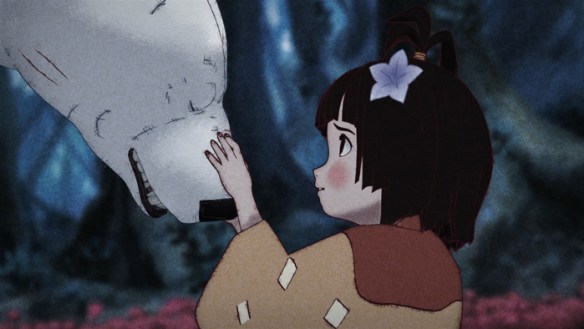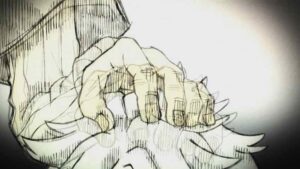Hello folks, and welcome back to Wrong Every Time. This week has seen my house cleaning up various media odds and ends, as we finished off the two revival Slayers seasons, concluded season three of Dimension 20, and also checked out the last of the millennium era Godzilla films. This has left my slate open for munching through the year’s outstanding must-watch anime productions, and thus I’ve already started a group viewing of The Summer Hikaru Died, while polishing off the last of Shoushimin Series in my own time. My big blind spot is the year’s top anime films – both the Umetsu and Fujimoto films actually released this year, alongside last year’s Yamada film that at this point should be widely available. I’ll be sure to munch through those as soon as I can, but in the meantime, let’s break down a fresh grab bag of film selections!
First up this week was Short Peace, the 2013 anthology film featuring anime shorts by Katsuhiro Otomo, Koji Morimoto, and others. The ostensible theme of this collection is “Japan,” as the features all highlight different eras of Japanese history, demonstrating both the social conditions and animating fears of their time periods. However, the anthology’s more unfortunate unifying feature is its heavy utilization of CG art, which would have seemed dated in 2013, and has not improved in the decade since.
Koji Morimoto’s brief opening avoids this issue, but both the first main segment Possessions (focused on a samurai attempting to escape a shrine filled with tsukumogami) and the third Gambo (about a battle between a polar bear and oni) are frequently undercut by the distance between their aesthetic aspirations and the low-poly models intended to realize them. What’s worse for Gambo is that the sequence also features some truly incredible traditional character animation, thus making it all the more disappointing whenever the young heroine suddenly becomes a PS3 character.
On the other hand, Otomo’s segment Combustible is an absolute marvel; while there are some CG models, they’re generally employed at such a distance that they meld well enough with the traditionally drawn backgrounds. This is likely only achievable because the segment is designed to replicate a traditional court tapestry, maintaining that specific three-fourths perspective as it details a story of a young woman despairing over her abandoned love. It’s a marvelous fusion of old aesthetic traditions and new technologies, demonstrating how CG can best be used to facilitate massive yet obscured crowd scenes, and basically embodying the highest calling of these sorts of anthologies – to illustrate new or alternate roads of animated storytelling, and thereby reveal the rich veins of original ideas still untapped by the industry.
Our next screening was Without Warning, a low-budget ‘80s horror feature bedecked with a splattering of ‘50s film stars. They, alongside your usual assortment of teens and an unfortunate boy scout troop, find themselves hunted by a mysterious alien menace, one which seems to kill humans largely for sport. Pursued by this beast and distrusted by their fellow humans, our survivors will have to use all their wits to overcome this superior being.
So yeah, it’s basically a direct predecessor to Predator, and even features the Predator-playing Kevin Peter Hall in the role of its own celestial antagonist. The special effects are gooey enough, and seasoned professionals like Jack Palance and Martin Landau do fine work, though I ultimately found myself somewhat disappointed by the film’s awkward structure. After an extended segment of screaming and running through the woods, our survivors manage to arrive at a backwoods diner, full of local yokels who all have their own opinions on the potential alien menace. The scene is a highlight, calling to mind The Birds’ standout diner-set pause in the storm, but nothing comes of it – our leads just return to running and screaming, rather than incorporating all these colorful new characters into some kind of thrilling final stand. Still, the film is a reasonable answer to the question “what if Predator was constructed as a traditional slasher,” and a passably diverting spooker on the whole.
Next up on our Godzilla journey was Godzilla vs Mechagodzilla, another entry directed by Jun Fukuda. In this one, the earth is once again under threat by aliens seeking to exploit a kaiju’s wrath, who have this time created a metal Godzilla to achieve their nefarious aims. Fortunately, Godzilla might just have an ally in this battle: the legendary King Caesar, an Okinawan deity prophesied to one day save the people.
This movie is so mean to Anguirus! He shows up just looking to hang with his buddy Godzilla, but it turns out it’s actually Mechagodzilla, who basically rips his jaw off! Anguirus barely manages to drag himself away from the fight, and is so distraught over the affair that he doesn’t show up again for thirty goddamn years, multiple eras of Godzilla canon into the future. He didn’t deserve any of that!
Anyway, mistreatment of Anguirus aside, Godzilla vs Mechagodzilla hews pretty closely to the post-Hedorah model of alien force, kaiju puppet, and eventual heroic collaboration, this time between Godzilla and the adorably Gremlin-like King Caesar. Caesar is clearly a Shisa, a lion-dog deity frequently seen in Okinawa, and his revival here effectively calls back to the Mothra sequences of the early Godzilla films. All that plus an unusually well-executed final battle makes Mechagodzilla a highlight of a generally weak era, essential mostly for its introduction of Godzilla’s mechanical menace.
Last up for the week was Wizards of the Lost Kingdom, another Roger Corman B-side from his ‘80s Argentinian film arc. This one centers on a young boy named Simon, son of the local kingdom’s court wizard. When an evil vizier claims power, Simon will have to team up with a ragtag group of would-be heroes to restore justice to the land, unlocking his own wizardly potential along the way.
Anyway, this one falls generally in line with Corman’s standard ‘80s output, save for two defining features. First, this film is inspired by Star Wars rather than Conan the Barbarian, meaning it’s more of a family adventure starring a not-Wookie and not-Han Solo and whatnot. And secondly, like Star Wars, it was largely built in the edit – or in this case, I guess you’d say “Frankensteined back to life in the edit,” complete with limbs scavenged from entirely separate organisms. There’s a good fifteen minutes of footage cribbed from Sorceress and Deathstalker in here, clumsily stapled in wherever the film could theoretically fit a vignette or flashback. Yet in spite of relying on entirely discordant entrails of unrelated films, Wizards of the Lost Kingdom is nonetheless one of the better Corman films of this era, owing entirely to the substantial charisma of Han Solo stand-in Bo Svenson. The guy’s a genuinely charming on-screen presence, and greatly aids Wizards of the Lost Kingdom in resembling a real movie.




